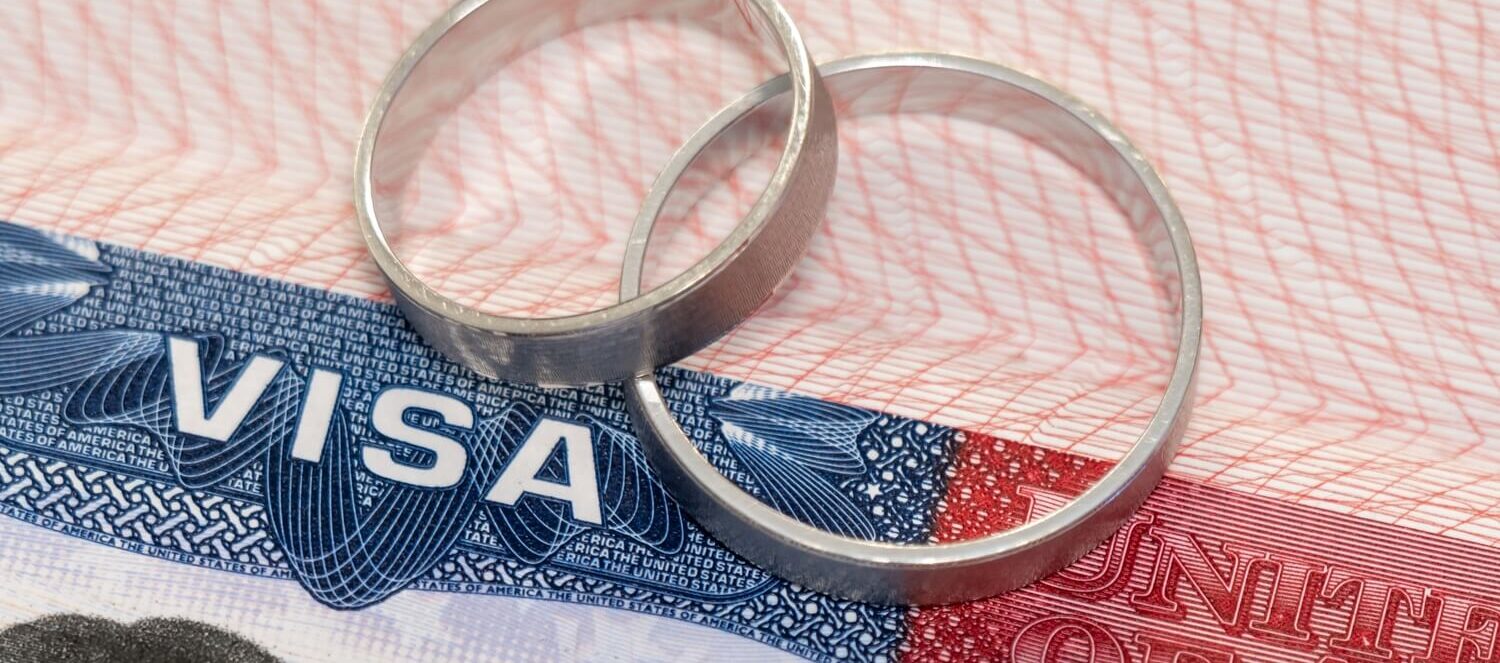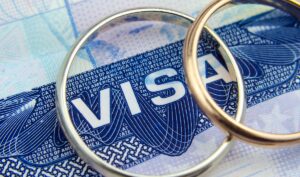
The K-3 visa process was designed to help shorten the physical separation between a U.S. citizen and their foreign-citizen spouse. In theory, it’s the perfect solution for many couples that want to move to the United States together without an extended separation associated with the immigration process. In practice, this strategy is rarely effective, and the foreign spouse ultimately enters the U.S. with an immigrant visa. While the K-3 visa remains a component of immigration law, most couples have a difficult time obtaining one.
K-3 Visa Explained
The K-3 visa is a temporary (nonimmigrant) visa for the foreign-citizen spouse of a U.S. citizen. A U.S. citizen may request the use of the K-3 visa process to shorten the physical separation with their foreign citizen spouse.
Typically, the wait for an immigrant visa (green card) can take several months. The I-130 processing time and subsequent visa processing can often delay a couple's ability to be together for more than a year. Thus, Congress created a K-3 visa so that the foreign spouse could enter the United States to await approval of the I-130 petition.
After obtaining the K-3 visa, the foreign spouse may enter the United States to await approval of the I-130 petition or adjust status. Most K-3 visa recipients choose to adjust status to a permanent resident once inside the U.S. Eligible children of K-3 visa applicants receive K-4 visas. Both K-3 and the K-4 visa recipients may stay in the United States while immigrant visa petitions are pending approval by U.S. Citizenship and Immigration Services (USCIS).
In fact, the K-3 visa for spouses is similar to the K-1 visa for fiancés. That’s why the two use the same petition.
Typical Scenario Addressed by K-3 Visa Process
The following hypothetical example illustrates how the K-3 visa process works.
John is a U.S. citizen working in China. During his employment, he meets a Chinese citizen named Mei, and the couple eventually marries in China. John’s employer asks him to repatriate to a U.S. location. The couple will be moving to the United States, so Mei needs to obtain an immigrant visa (green card). John needs to be back in the U.S. within six months, but the immigration process could take a year or more. John and Mei are concerned about the separation and the added expenses of visits. Complicating issues further, the couple has a child that could be separated from his father during the transition.
By obtaining a K-3 visa (and K-4 visa for the accompanying child), the family stays together. Mei and child travel to the United States with John.
Once in the U.S., Mei and child can adjust status to permanent residence instead of applying via the U.S. embassy in China. While the entire process might take slightly longer, the family stays together during the wait.
How to Apply for a K-3 Visa
Eligibility for the K-3 visa process is fairly straightforward. The intending immigrant must :
- Be married to a United States citizen; and
- Have a pending Form I-130 (Petition for Alien Relative).
In other words, this process is only availble to the spouse's of U.S. citiens, and the I-130 petition must be filed. You cannot bypass the I-130 petition.
Approximately two to three weeks after filing the I-130 petition, USCIS will mail the petitioner an I-797C Notice of Action that confirms receipt of the petition. Once the U.S. citizen receives this receipt letter (I-797C), they may file Form I-129F, Petition for Alien Fiancé(e), to request the K-3 visa. However, when requesting a K-3 visa, there is no USCIS filing fee form Form I-129F.
If there are children that will accompany the foreign spouse to the United States, the U.S. citizen is not required to file separate I-129F petitions for each child. Instead, list the child(ren) on the same Form I-129F.
Steps for the K-3 Visa Process
As explained above, the U.S. citizen must first file Form I-130 and receive the receipt letter before they can file Form I-129F, Petition for Alien Fiancé(e), on behalf of the foreign spouse.
File the K-3 Visa Petition
File Form I-129F with all required supporting documents described in the I-129F filing instructions. Need help? CitizenPath provides an affordable online system designed by immigration attorneys to make sure you do this correctly. After USCIS approves the petition, they will send it to the National Visa Center (NVC) for additional processing.
National Visa Center Processing
If the NVC receives the approved I-129F petition before it receives the approved I-130 petition, the NVC will process the I-129F petition. However, if the I-130 petition is approved first, NVC will administratively close the K-3 case. This is because the case is moot. There is no need for the K-3 visa once the immigrant visa is available. In these cases, the foreign spouse will be redirected to complete the immigrant visa process through consular processing.
K-3 Visa Interview
Assuming the NVC receives your approved Form I-129F first, it will forward it to the U.S. embassy or consulate in the country in which you were married. The U.S. embassy or consulate will send the couple instructions on finalizing the K-3 visa application. They will require the foreign spouse to undergo a medical examination and an interview.
Enter the United States
The foreign spouse may enter the United States after the U.S. embassy or consulate approves the case and issues a K-3 visa. An immigration officer from the U.S. embassy or consulate will provide a sealed packet which contains your K-3 visa and any additional documents you provided. Do NOT open the sealed packet. When you enter the United States, a Customs and Border Protection officer will open the packet.
While in the United States, you may begin your adjustment of status (green card) application even if your I-130 petition is still pending. You may also obtain employment authorization if you file a Form I-765 Application for Employment Authorization.
The K-3 visa is generally valid for two years. The visa holder may travel and reenter the U.S. multiple times.
Required Documentation for K-3 Visa Process
The U.S. embassy or consulate will require the foreign-national spouse (and any eligible children applying for K-4 visas) to bring the following forms and documents to the visa interview:
- Completed Form DS-160, Online Nonimmigrant Visa Application. The applicant (and any eligible children applying for K-4 visas) must: (1) complete a single Form DS-160 and (2) print the DS-160 confirmation page to bring to the K-3 interview.
- A passport valid for travel to the United States and with a validity date at least six months beyond the intended period of stay in the United States.
- Civil documents - the original(s) (or certified copies) and photocopies of the following:
- Birth certificate
- Marriage certificate for the marriage to the U.S. citizen spouse
- Divorce or death certificate(s) of any previous spouse(s)
- Police certificates from present country of residence and all countries where the applicant has lived for 6 months or more since age 16. (Police certificates are also required for accompanying children age 16 or older.)
- Medical examination (with vaccinations recommended)
- Evidence of financial support (Form I-134, Declaration of Financial Support may be requested)
- Two (2) 2"x 2" passport-style photographs
- Evidence of relationship with the U.S. citizen spouse
- Payment of fees
All documents not written in English, or in the official language of the country from which you are applying, must be accompanied by certified translations.
Why Your K-3 Visa Petition is Likely Dead on Arrival
The K-3 visa process may sound like a great solution for your situation. It is. Unfortunately, most couples are unlikely to obtain a K-3 visa. Consider the statistics. In fiscal year 2023, the U.S. Department of State issued only six K-3 visas as compared to 88,586 immigrant (IR1/CR1) visas for the spouses of U.S. citizens.
There is no official explanation why there’s such a great disparity. Speculation exists that the NVC and USCIS conspire to limit K-3 visas by delaying K-3 processing until the I-130 petition can catch up. If the I-130 is approved, there’s no reason to issue a K-3 visa, and the application can be administratively closed.
Fortunately, there is no USCIS fee to file the K-3 visa petition. You may apply for the K-3 visa, but you should also understand the likelihood of receiving one. It’s extraordinarily low. For the purposes of planning your move, it’s often easier to rely a more predicable process – the immigrant visa.
Is the K-3 Faster Than a Spouse Visa?
Absolutely, the K-3 visa process was designed to be faster than the spouse visa. In reality, it is not a reliable solution for couples wanting to reunite. Marriage-based spouse visas are taking longer than ever. Unfortunately, K-3 visa processing times have grown equally as lengthy. This has caused The K-3 visa process to freeze up. The U.S. Department of State will only grant the K-3 if it can be issued before the spouse visa.
About CitizenPath
CitizenPath provides simple, affordable, step-by-step guidance through USCIS immigration applications. Individuals, attorneys and non-profits use the service on desktop or mobile device to prepare immigration forms accurately, avoiding costly delays. CitizenPath allows users to try the service for free and provides a 100% money-back guarantee that USCIS will approve the application or petition. We provide support for the Immigrant Visa Petitition Package (Form I-130), K-3 Visa Petition (Form I-129F), and several other immigration services.
Want more immigration tips and how-to information for your family?
Sign up for CitizenPath’s FREE immigration newsletter and
SAVE 10%
on our immigration services







